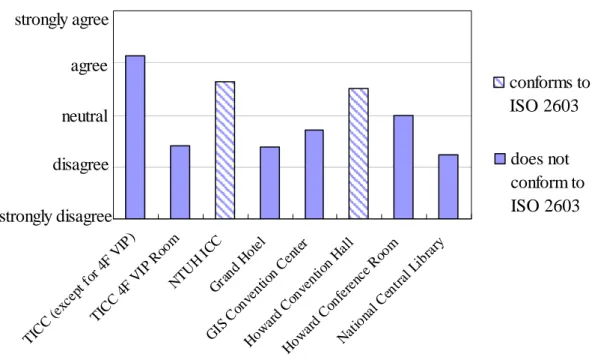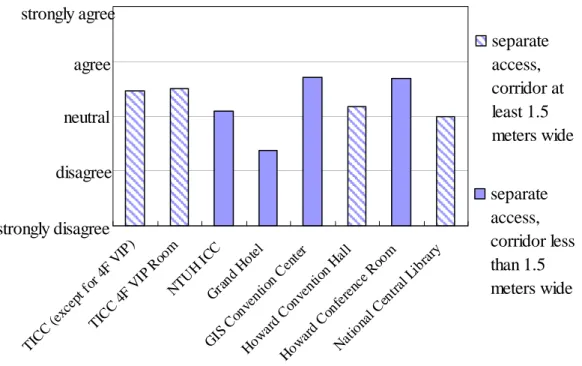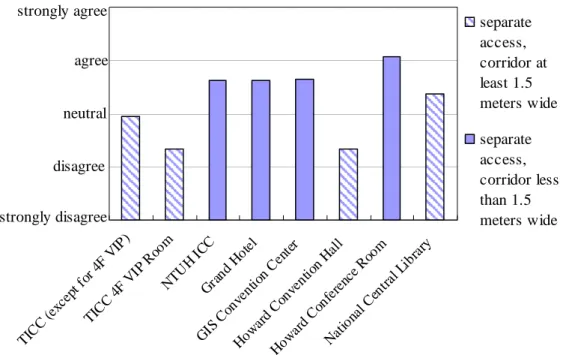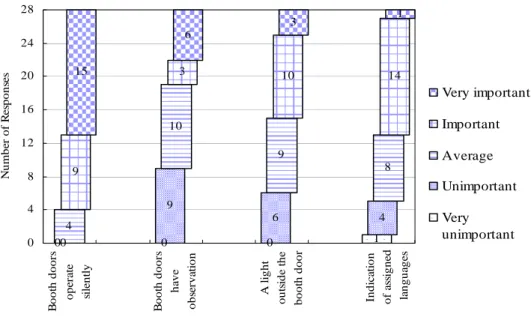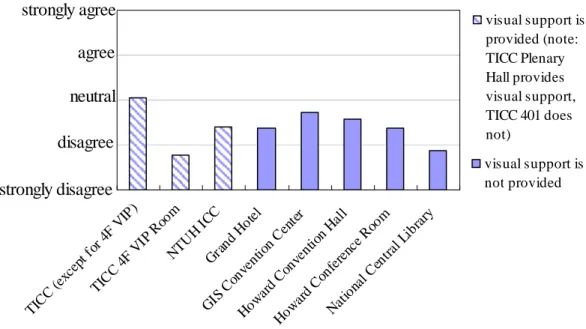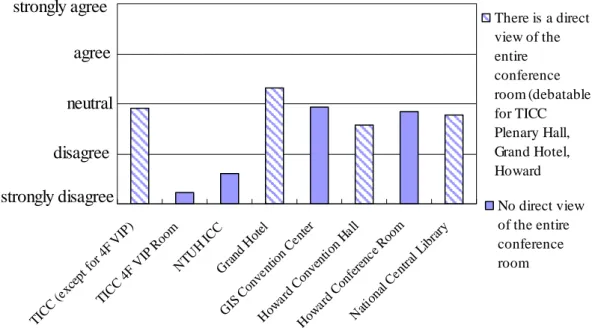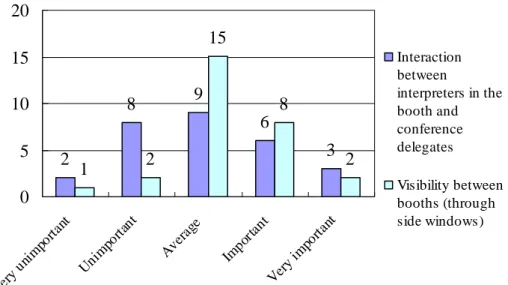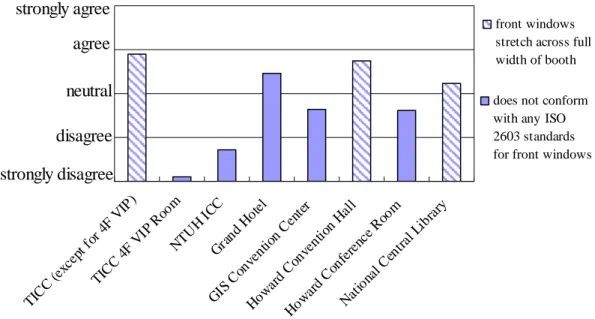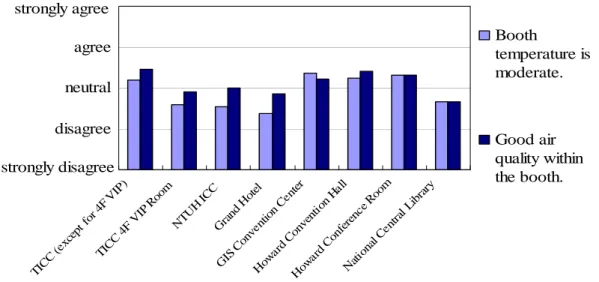CHAPTER FIVE
DISCUSSION AND RECOMMENDATIONS
5.1 Introduction
The main goal of this study is to examine the current booth conditions in Taipei
in comparison with standards set in ISO 2603, ascertain the importance given to
various booth factors by interpreters, and determine whether interpreters’ needs with
regard to the booth environment are fulfilled. After conducting the POE methods of
field studies, questionnaire, and interviews, the results of this study have been
presented in the previous chapter. This chapter discusses some general trends and
implications which can be observed from the findings. Section 5.2 will present an
analysis of the findings, their implications, and recommendations as given by the
interpreters interviewed, and a compilation of recommendations for improvement of
existing booths is presented in Section 5.3.
5.2 Booth Factors
In Chapters 2 and 4, a number of factors were discussed, including booth size,
access, doors, visibility, windows, ventilation, lighting, seating, and working surface.
This section will discuss the analysis of results presented in the previous chapter, as
well as their implications and interpreters’ recommendations for improvement.
15.2.1 Booth Size
Interpreters responded in the survey questionnaire that booth size was
somewhere between important and very important, with a weighted average of 4.18.
The following figure presents how well interpreters feel various booths fulfill their
needs in terms of booth size, as well as whether or not the booths in question
conformed to the objective requirements of ISO 2603. Analysis of variance (ANOVA)
shows that the results for responses towards the booth size of various booths are
statistically different. As seen in Figure 5.1, the conformance or non-conformance has
some relation to how well interpreters’ needs are fulfilled. However, it is interesting to
note that while the booths of the TICC, with the exception of VIP Room booths, do
not conform to ISO 2603, they are more satisfactory than the two booths which do.
This may be explained by the fact that the TICC’s nonconformance in terms of booth
size is slight, being only approximately 20 centimeters short of ISO 2603’s
requirement for depth of booth, while the size of the other two conforming booths
may be deceptive. The NTUH International Convention Center’s booths are indeed
1
Please note that since the field studies include booths from the VIP Room, 401, and Plenary Hall in
TICC, whereas the questionnaire only differentiates between VIP Room booths and non-VIP Room
booths in TICC, the column “TICC (except for 4F VIP)” in the figures of this chapter shall refer to all
booths in the TICC, including both the Plenary Hall and 401 booths, with the exception of VIP Room
large; however, much of the space is not used by the interpreters, as one wall is
covered in shelving, the working surface does not stretch across the full width of the
booth, and interpreters may be forced to remain on one side of the room due to the
small window. The booths of Howard International House Taipei’s Convention Hall,
although large enough, are irregularly shaped, which may account for unused space
and the lower response in relation to the TICC.
does not conform to ISO 2603 conforms to ISO 2603
strongly disagree disagree
neutral agree strongly agree
TI C C (e xcep t f or 4F
V IP )
TI CC 4 F V
IP Ro om
NT U H IC C Gr an d H ote l
GI S C
on ve nt io n C en te r
Ho wa rd C on ve nt ion H al l H ow ar d Co
nf er en ce R oo m N at ion al C entr
al L ibr ar y
Figure 5.1. Questionnaire responses to “The size of the booth fulfills my needs” with differentiation between conformity and nonconformity with ISO 2603
ISO 2603 also stipulates that “for conference halls with up to six booths, one or
more should be 3.2 meters wide” and “for conference halls with more than six booths,
all booths shall be at least 3.2 meters wide”, in order to accommodate the continuous
presence of three interpreters. None of the booths surveyed, except for the NTUH
International Convention Center booth, are at least 3.2 meters wide. This study
speculates that this lack of adherence to ISO 2603 standards is due to Taiwanese
interpretation practices, in which very few conferences employ three interpreters to a
booth, as confirmed by Subjects F and G. Even fewer venues have more than six
booths, since seldom do conferences in Taiwan need over six language channels.
Implications:
As mentioned in Chapter 2, insufficient booth size can cause problems with
ventilation and a constant jostling of elbows, which can be a constant distraction to
interpreters who need to maintain a high level of concentration on conference
proceedings.
Insufficient booth size can be the result of designers’ lack of understanding for
interpreters’ needs. As mentioned in Chapter 4, Subjects C and D believe that overly
small booths may be due to designers’ misconception that conference interpreters
work alone in a booth, rather than in teams of two. However, this study cannot
confirm whether or not designers have misconceptions regarding interpretation
practices, since no interviews with architects were conducted. This lack of
understanding not only affects booth size, but other factors as well, as will be
described in later sections.
Interpreters themselves seem to be rather tolerant of small booths, as none of the
booths surveyed reached the ISO 2603 requirements, except in cases where the
nonconformance is severe, as can be seen in the booths of the TICC VIP Room,
Grand Hotel, GIS, and NCL. On the other hand, it is possible that the requirements of
ISO 2603 are too demanding, as interpreters seem quite satisfied with TICC booths
(except for 4F VIP), with its slight nonconformance. Another possibility is that
Taiwan interpreters are smaller in physique, hence the need for less space. However,
even if the latter is true, booth size should still be designed to provide adequate room
for interpreters with larger physiques.
The practice of conference interpretation in Taiwan also seems to support
nonconformance to ISO 2603 in terms of booth size. The lack of conferences
employing three interpreters to a booth and the predominance of conferences held
solely in Mandarin-English or Mandarin-Japanese languages result in few booths
large enough to support three interpreters. The Taiwan T&I Study (2004) shows that
over 60% of freelance interpreters believe that the interpretation market will remain
stable, and the need for various language combinations will remain the same.
However, just because there is no practice of working three in a booth at the current
time, doesn’t mean that this practice will not develop later. It may be prudent for some
of the larger and more popular venues to prepare for this need, especially since this
may attract large-scale conferences utilizing many languages.
Another possible cause of discrepancy between the standard ISO 2603 and
current conditions is the opposing points of view from conference hall operators and
interpreters. It is possible that conference hall operators and designers feel that small
booths are adequate, given that they are not constantly in use. However, rare use does
not excuse a lack of sufficient size. Restrooms for persons with disabilities, although
also not constantly in use, are required to be of a certain size. In both the cases of
interpreters’ booths and restrooms for the disabled, it is the function for which the
space is designed for and not the frequency of use which dictates its size. It is
therefore in the conference hall operators’ best interests to provide sufficient space for
interpreters to work without discomfort or distraction, in order to produce “optimal
quality” interpretation (Moser-Mercer, 1996).
Recommendations:
In the interview findings of Chapter 4, Subjects B and C recommend that booths
which are too small should be enlarged by taking down the partition wall and
combining two booths into one.
Since interpreters have very little contact with architects, they should make their
needs known to PCOs, conference organizers, and conference hall operators,
emphasizing the interpreters’ role in a conference’s communication process and the
need for sufficient booth size, rather than silently bearing with less than desirable
working conditions. With the findings of this study and other relevant research,
conference hall operators should reassess the working conditions provided for
conference interpreters. Whether renovating existing booths or designing new ones,
conference hall operators should convey the importance of interpreters’ booths to the
designers, who should then consult interpreters or ISO 2603 during the design process.
It is far less costly to conform to requirements from the outset, than to enlarge and
renovate the booths afterwards. Ergonomic requirements are consulted and adopted
for office and other workstations, and ISO 2603 should be adopted here.
5.2.2 Access
In the questionnaire, interpreters responded that easy access to the booth was
important with a weighted average of 4.00, and a separate entrance from the hall and
distance between interpretation booth and sound control booth were statistically less
so, with weighted averages of 3.39 and 3.68, respectively. Figure 5.2 presents
interpreters’ opinions as to the accessibility of various booths, which are statistically
different from one another. The figure also seems to show no direct relation between
the width of the access corridor and interpreters’ perception of easy access, as two of
the booths with narrow access corridors, GIS and Howard Conference Room, were
rated as relatively highly accessible in the questionnaire.
separate access, corridor less than 1.5 meters wide separate access, corridor at least 1.5 meters wide strongly agree
agree
neutral
disagree
strongly disagree
TIC C (ex
cep t f or 4F
VI P)
TI C C 4F V IP R
oo m NT U H I
CC Gr an d H ot el
G IS C on ve nt ion C ent er
H ow ar d C on ve nt ion H al l
H ow ar d C on fe ren ce Ro om N at io na l C en tral Li bra
ry
Figure 5.2. Questionnaire responses to “I can easily access the booth” with differentiation between widths of access corridor
However, other factors must be taken into account when discussing accessibility,
one of which is the location of the sound control booth and its distance to the
interpreters’ booth, which is shown in the Figure 5.3. The figure shows that booths
which are located close to the sound control booth tend to have narrow access
corridors. These booths share a corridor with the sound control booth, which is
generally not accessible by the public, meaning that designers may feel that less than
1.5 meters is sufficient width for a corridor. Whereas booths located further from the
sound control booth often open up to corridors accessible by the general public, which
are much wider.
strongly disagree disagree neutral agree
separate access, corridor less than 1.5 meters wide separate access, corridor at least 1.5 meters wide strongly agree
TI C C (e xcep
t f or 4F V IP ) TI C C 4
F V IP R oo m
NT U H I CC
Gr an d H ot el
G IS C on ve nt ion C ent er H ow ar d C on ve nt ion H al l
H ow ar d C
on fer en ce R oo m Na tion
al C en tra l Li br ar y
Figure 5.3. Questionnaire responses to “The sound control booth is not located too far from the interpreters’ booth” with differentiation between widths of access corridor
Implications:
Generally speaking, interpretation booths should not be located too far from the
sound control booth, since interpreters and technicians need to communicate in the
case that problems arise. However, according an interview with Subject H,
interpreters are less than pleased to have to cross through the sound control booth to
reach the interpretation booth, probably because access is more difficult possibly due
to narrow corridors and the multitude of equipment and cables in the path.
Recommendations:
Since interpretation booths, sound control booths, restrooms, and other amenities
are usually fixed, architectural structures, there is no feasible way to improve access
other than a complete renovation, which is costly and not likely to be undertaken by
the conference hall operator. Therefore, it is imperative that designers be aware of the
issue of access during the design process by consulting interpreters or ISO 2603 in
order to avoid future repercussions.
5.2.3 Doors
Unsurprisingly, interpreters responded in this study’s survey questionnaire that it
was important for booth doors to operate silently, with a weighted average of 4.39,
which five of the nine booths surveyed complied with. They deemed it statistically
less important that doors have observation portholes, a light outside indicating an
active microphone, and indication of assigned languages and channels outside. The
breakdown of interpreters’ responses is shown in the Figure 5.4.
00 0 0 1
9
6 4
4
10
9 9 8
3 10 14
15
6
3 1
0 4 8 12 16 20 24 28
Booth doors operate silently Booth doors have observation A light outside the booth door Indication of assigned languages
Number of Responses
Very important Important Average Unimportant Very unimportant
Figure 5.4. Distribution of questionnaire responses to the importance of door-related
factors
It is interesting to note that while the importance of silently operating doors is
clearly of importance to interpreters, the importance given to the other three factors is
much less so. The existence of observation portholes may indeed allow outside
individuals to enter the booth with more care, or indeed dissuade them from
disturbing the interpreters at work, but the difference of opinion may also depend on
the interpreters’ differing regards for privacy. The responses towards indication of
assigned languages and channels are also somewhat mixed; however, this study
speculates that because many of the conference use only English/Mandarin channels
(over 80% of the conferences, by one PCO’s estimate), perhaps English/Mandarin
interpreters are unaware of this need, whereas interpreters of other languages, such as
Subject F, feel strongly about the need for indication.
Implications:
Interpreters need a working environment which is free from distraction, since
interpretation requires intense concentration. Doors which produce sound can be one
such distraction. During the course of a conference, materials may be passed into the
booth for the interpreters’ reference, and while one interpreter is working, the other
may need to step out for a drink of water or to use the restroom. Hence, it is important
that doors operate silently as not to disturb the interpreters working.
The need for a porthole in the door or light indicating an active microphone is
less clear in this study. Therefore, further studies may be needed to understand the
interpreters’ preference in this matter.
A lack of signage can be overlooked when only one booth is in use. However, in
the case that more than one booth is in use, it is preferable to have indication of
languages and channels outside booth doors to avoid confusion among interpreters,
technicians, and conference operators, who may need to pass along information or
materials to the interpreters.
Recommendations:
Doors should operate silently so as not to cause a disturbance to the working
interpreters.
Signage or indication of languages and channels should be posted outside the
booth door in the case that more than one booth is in use during a conference in order
to avoid confusion. In addition, one interpreter added that signs should be posted
outside booth doors to remind passer-bys to be quiet, as doors are often the weak
point in the soundproofed environment of the booth.
5.2.4 Visibility
The importance of visibility has already been emphasized and reported in the
previous chapters. To summarize the questionnaire results of Chapter 4, interpreters
found the visibility of the speaker’s facial expressions, the podium/rostrum, provision
of visual support, view of the entire conference room, and visibility of interaction
among conference participants to be quite important, with the weighted averages of
4.57, 4.86, 4.75, 4.36, and 4.25, respectively.
However, as important as this factor is, it is apparent that interpreters generally
feel that booths surveyed offer poor visibility. In the field studies, visibility received
an overall compliance rate of 45%. Figures 5.5 and 5.6 presents the responses of
interpreters, where they, for the most part, disagree or strongly disagree with the
visibility of the speaker’s facial expressions and the entire conference hall.
Interpreters’ responses with regard to the visibility of the speaker’s facial expressions
have been compiled along with the booths’ provision of visual support, due to this
study’s initial speculation that the latter may have some influence on the former, into
Figure 5.5, as seen below. However, as the figure shows, there is no apparent relation
between the provision of visual support and the visibility of the speaker’s facial
expressions. The relatively higher rating of TICC booths (excepting VIP Room booths)
is due to the fact that this study failed to take into account the different locations of
the numerous booths in relation to various conference halls at this venue.
strongly disagree
visual support is provided (note:
TICC Plenary Hall provides visual support, TICC 401 does not)
visual support is not provided
strongly agree agree neutral disagree
TI CC
(e xc ept fo r 4F V IP )
TI C C 4F V IP R
oo m NT
U H IC C G ran d H
ot el
GI S Co nv en tion
C en ter
Ho w ar d C
on ve nt io n H al l
H ow ar d C
on fer en ce Ro om Na tio na l C ent ra l L ibr ar y
Figure 5.5. Questionnaire responses to “I can see the speaker’s facial expressions”
with differentiation between provision of visual support.
Figure 5.6 presents the responses of interpreters towards the visibility of
conference halls from various booths. The differentiation of solid and striped bars
represents the findings of the field studies; however, many of them are rather
subjective since, as mentioned in Chapter 4, the issue of having a direct view may be
open to interpretation and personal opinion. Again, the responses for TICC booths
(excepting VIP Room booths) may be inaccurate, due to this study’s lack of
consideration for the different sitings for various booths in this venue. Other factors
that must be taken into account include the size of the hall and the angle at which the
booth is positioned.
strongly disagree disagree
neutral agree strongly agree
No direct view of the entire conference room
There is a direct view of the entire conference room (debatable for TICC Plenary Hall, Grand Hotel, Howard
TI C C (e xc ept for 4F V IP )
TI CC 4F
V IP Room NT
U H ICC Gr and
H ote l
G IS Conve nt ion C
en ter
H ow ard Conve nt ion H
al l
Ho w ar d Conf
ere nc e Room
N at iona l Ce
nt ra l L ibra ry
Figure 5.6. Questionnaire responses to “I have a good view of the conference hall from the booth” with differentiation of findings from the field studies
Despite the high importance given to most aspects of booth visibility by
interpreters, the interaction between interpreters and delegates as well as the visibility
between booths through side windows is statistically less important, with a weighted
average of 3.00 and 3.29 respectively. A breakdown of questionnaire responses is
presented in the following figure, Figure 5.7.
2
8 9
6
3
1 2
15
8
2 0
5 10 15 20
V ery
u ni m po rta nt
U ni m po rtan t
A ver ag e
Im por tan t
V er y im po rtan t
Interaction between
interpreters in the booth and conference delegates Visibility between booths (through side windows)
Figure 5.7. Distribution of questionnaire responses to the importance of interaction between interpreters and delegates and visibility between booths
The interviews with interpreters provided some insight as to this difference of
opinion. Some felt that visibility of interpreters in other booths was not necessary,
mainly because, as mentioned before, a majority of the conferences held in Taipei use
only Mandarin and English, hence no other booths are in use. However, some felt that
this factor was important, especially when other booths were in use and when
interpreters were doing relay interpretation. The importance of interaction between
interpreters in the booth and conference delegates was equally divided. Interpreters
responded in the interviews that this was a nice thing to have, but for the most part,
interaction between interpreters and delegates was nonexistent, which may explain the
distribution of responses.
Implications:
As mentioned in Chapter 2, if interpreters cannot see, they cannot interpret.
Perhaps the common misconception among non-interpreters is that interpreters need
only to hear the message to interpret. This does not take into account the nonverbal
messages that may be conveyed during a conference. The potential effects of poor
visibility from the simultaneous interpretation booths may be the interpreter’s
discomfort, distress, or poor-quality or inaccurate interpretation, which may then
affect the audience’s understanding and the speaker’s ability to communicate with the
audience.
Since most aspects of visibility were rated as quite important in the questionnaire,
and interpreters also responded that they generally could not see the speaker’s facial
expressions nor did they have a good view of the conference hall, it is quite clear that
this is one of the factors which interpreters feel strongly about and are less than
satisfied with.
Recommendations:
As reported in the interview findings of Chapter 4, interpreters felt it was
necessary to bring in visual support in the form of monitors to facilitate the
interpretation process in booths with poor visibility. One interpreter even suggested
that all booths should be fitted with monitors, since interpreters needed to read the
fine print on slides that are often located too far to discern. Although PCOs and
interpreters themselves are very much aware of the importance of visibility to the
interpretation process, other related parties, such as conference hall operators,
conference hall designers, conference organizers, and possibly even the speakers and
audience members, should be made aware of this need, so as to ensure the quality of
interpretation and pleasant conference proceedings. Even though the installation of
monitors will present an additional cost for conference hall operators, the findings of
the questionnaire and interviews have sufficiently expressed the necessity of seeing
the speaker’s facial expressions and slides for quality interpretation.
Regardless of whether the interpreters wish to see the speaker’s facial
expressions, the podium, or the audience, an interpreter’s ability to see outside the
booth is largely related to the design of booth windows, which will be discussed in the
following section.
5.2.5 Windows
As with visibility, interpreters found booth windows to be highly important
factors, with a weighted average of 4.50 for the size of front windows. Overall, the
compliance rate for windows is 23%, as found in the field studies. Figure 5.8 presents
whether the front windows of various booths fit interpreters’ needs, as well as the
distinction between booths whose windows do and do not conform to ISO 2603.
strongly disagree agree strongly agree
does not conform with any ISO 2603 standards for front windows
disagree neutral
front windows stretch across full width of booth
TI C C (e xcep t fo
r 4 F V IP )
TI C C 4 F V IP R oo m
NT U H ICC
Gr an d H ote l
G IS C on ve nti on C en ter H ow ar d C on ve nt io n H al l
H ow ar d C on fer en ce Ro om
N at io na l C en tra l L ib rar y
Figure 5.8. Questionnaire responses to “The size of the front windows fulfills my needs” with differentiation of findings from the field studies
Unsurprisingly, front windows of booths which conform, albeit somewhat, to
ISO 2603 are among those which interpreters feel fulfill their needs in terms of
window size. The front window of the Grand Hotel booths was considered the most
satisfactory among the nonconforming booths, since they nearly stretch across the full
width of the booth. In addition, the booths of the Grand Hotel are located on the
mezzanine level, where the height of the window is not quite such a big issue for
interpreters’ line of sight. The front windows of GIS and Howard Conference room
measure 80cm by 110cm and 114cm by 150cm, respectively, and are placed quite
high above the working surface, forcing interpreters to stand to see out of them. The
front window of the NTUH International Convention Center is quite similar,
measuring 93cm wide by 90cm high, placed 30cm above the working surface. Its size
seems even smaller in comparison with the wide expanse of the front wall, which is
4.07 meters across. From the findings of the field studies and questionnaire, it is
apparent that the TICC VIP Room booth window is the worst.
As mentioned in Chapter 4, only TICC booths (with the exception of VIP Room
booths) are fitted with side windows. One PCO mentioned that an overwhelming
majority of conferences which use simultaneous interpretation only uses one booth,
mostly for Mandarin/English channels. She estimates that fewer than 10% of
international conferences use three or more booths, and speculates that the number
may be even smaller than that. Thus, with the frequency of more than three booths of
a hall in use at the same time being so small, it is not surprising that side windows are
overlooked and not incorporated into many of the conference venues. Another
possible explanation is that designers simply were unaware of the need for side
windows.
Interpreters also considered it quite important that windows do not cast off glare,
giving it a weighted average of 4.46, and it was found in field studies that most of the
booth windows cast some level of glare, the exceptions perhaps being the TICC VIP
Room and Grand Hotel booths, due to overly small windows and insufficient lighting,
respectively. However, as Figure 5.9 shows, interpreters feel that the windows of
TICC VIP Room and NCL booths cause more glare, statistically speaking.
strongly disagree disagree neutral agree strongly agree
TI C C (ex cep
t f or 4F V IP )
TI CC 4 F V
IP Ro om
N TU H IC C
Gr an d H ote l
GI S C
on ve nt io n C en te r
H ow ar d C on ve nt ion H al l
H ow ar d Co
nf er en ce R oo m N at ion al C en tra l Li
br ar y
Figure 5.9. Questionnaire responses to “The front windows do not cause glare”
Implications:
Obviously, window size is important; not only for itself, but for how well
interpreters can see out of it. In Chapter 4, some interpreters responded that it was not
so much the width of the window which was important, but rather the height at which
the window is placed, because it dictates whether or not interpreters will be able to see
while seated. The fact that so many booth windows are placed so high above the
working surface implies either a lack of consideration towards booth design or the
misunderstanding that interpreters work standing up.
Recommendations:
First, the front windows of interpretation booths should be enlarged, according to
interpreters interviewed, and placed at a height suitable for seated interpreters to see
out of. Ideally, the lower edge of the front window should be level with the working
surface, per the requirements of ISO 2603, to ensure that the interpreters’ line of sight
not be obstructed. In addition, windows should use untinted glass so that interpreters
will not be hampered by glare and be able to clearly see the conference proceedings.
Another suggestion would be to raise the floor level of the booth, thereby concealing
cables and wires beneath the flooring and bringing the interpreters up to a height
where they may more comfortably see out the window.
Second, although the importance of side windows is often overlooked, and
thought of as important only in situations requiring relay interpretation, considering
that Taiwan is moving towards globalization and closer cooperation with international
partners, the number of conferences using multiple languages and relay interpretation
can only increase, possibly resulting in a future need for more and more booths
equipped with side windows. In light of this, it is recommended that conference halls
which frequently use multiple languages and channels ensure that side windows are
placed to allow visual communication between booths.
5.2.6 Ventilation
In the previous chapter, interpreters stressed the importance of ventilation,
revealing through interviews that poor ventilation can cause distraction, discomfort,
and even adversely affect an interpreter’s performance. From the questionnaire,
interpreters expressed that all ventilation factors surveyed are important to very
important. Figure 5.10 presents questionnaire results, showing that interpreters are not,
on the whole, satisfied with the temperature and air quality in various booths. More
than one interpreter remarked that the booths at Grand Hotel are exceptionally cold,
which is also somewhat noticeable from Figure 5.10.
strongly agree
neutral
strongly disagree agree
disagree
TICC (excep
t fo r 4F VIP
)
TICC 4F VIP
Room NT
UH ICC
Gra nd Ho
tel
GIS Co
nvention Ce
nter
Howard Co
nvention Hall
Howard C onf
erence Ro om
National Cent ral Library
